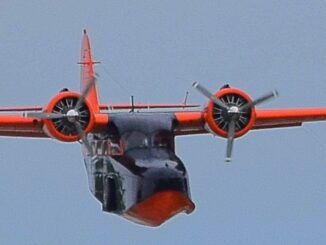

On October 16, 1937 the Short Sunderland, a remarkable British flying boat, sailed through the water and the sky, leaving innovative trails behind. Developed for the Royal Air Force (RAF) in the late 1930s and named after the town of Sunderland in North East England, this aircraft was primarily designed for long-range maritime patrol missions. Its development, operational history, and technical specifications made it one of the most capable and widely used flying boats of its era. The Short Sunderland’s origins can be traced back to the British Air Ministry’s Specification R.2/33, issued in 1933, which called for a next-generation general-purpose flying boat for ocean reconnaissance. The aircraft was to serve as a successor to the Short Sarafand flying boat and perform long-range patrol and reconnaissance missions over the open ocean. The Sunderland was developed in parallel with the Short S.23 Empire flying boat, which was designed for civilian purposes. While both aircraft shared design features, the Sunderland incorporated additional military modifications such as defensive armaments and bomb storage.

Competition and Winning Design
The early 1930s saw a rise in international competition for long-range aircraft, especially between British, American, and German manufacturers. This led to the development of aircraft such as the Sikorsky S-42 and Dornier Do X, which influenced the UK’s push for an advanced flying boat. The Short Brothers responded to this demand with the S.23 Empire, which won a contract from Imperial Airways to transport overseas mail. The successful civilian program paved the way for the military-focused Sunderland. The Sunderland, though heavily based on the S.23, featured significant design differences tailored to its military purpose. Armament and defense were key priorities, with early design changes made to accommodate feedback from the Air Ministry. The nose turret, initially equipped with a Vickers K machine gun, was later switched to a Browning machine gun. The tail turret evolved into a powered version, incorporating four Browning machine guns. These enhancements, along with an increased center of gravity adjustment through the addition of forward ballast, ensured that the Sunderland could effectively defend itself while maintaining balance during flight.

The first Sunderland prototype, designated K4774, was an outcome of the brainstorming and a successful design process. The prototype made its maiden flight on October 16, 1937. The aircraft was powered by Bristol Pegasus X radial engines, each producing 950 horsepower. The flight, conducted by John Lankester Parker, Shorts’ chief test pilot, and Harold Piper, was successful, lasting approximately 45 minutes. After initial tests, the aircraft underwent several modifications, including a wing sweepback to adjust the center of lift and accommodate the defensive armaments. By March 1938, the Sunderland had completed its post-modification flights, now equipped with the Bristol Pegasus XXII radial engines, which offered 1,010 horsepower.
High Wave Features
The Sunderland was a large, four-engine flying boat designed with an all-metal construction and flush-riveted panels. Its wings were thick and housed four nacelle-mounted Bristol Pegasus engines, providing ample power for long-range patrol missions. The aircraft featured a two-deck interior, with the lower deck equipped for extended missions, housing six bunks, a galley, and even a yacht-style porcelain flush toilet. Its flight control surfaces were metal-framed and covered in fabric for added weight savings. The Sunderland’s defensive and offensive capabilities were formidable. It carried four Browning machine guns in a powered tail turret and additional guns in manually operated positions on either side of the fuselage. It could also carry a 37mm gun and up to 2,000 pounds of bombs, mines, or depth charges in its bomb room. One of the Sunderland’s standout features was its impressive fuel capacity, which was crucial for long-range missions. Its six drum-style fuel tanks held 9,200 liters of fuel, later expanded to 11,602 liters with the addition of auxiliary tanks. The aircraft also boasted Gouge-patented flaps that increased lift during landing, improving its water performance by 30 percent.

As a flying boat, the Sunderland was uniquely equipped to operate in maritime environments. It featured demountable mooring masts, beaching gear, and a robust anchoring system, which allowed it to perform on water as well as in the air. The aircraft was steered using traditional flight controls like rudders and ailerons, and pilots could adjust engine power to manage direction during water operations. Its hull design included a “step” that facilitated planning, allowing the aircraft to break free from the water’s suction for takeoff.
A Wartime Workhorse
The Short Sunderland played a vital role during World War II, primarily in the Battle of the Atlantic. Tasked with countering the German U-boat threat, the Sunderland became a feared adversary for submarines. On July 17, 1940, a Sunderland from No. 10 Squadron RAAF achieved the type’s first unassisted U-boat kill, showcasing its lethal capabilities in maritime warfare. Sunderland also contributed to the Mediterranean Theatre, providing reconnaissance and logistical support during operations like the evacuation of Crete. Beyond combat, the Sunderland proved valuable for search-and-rescue missions, saving countless lives throughout the war.

The Sunderlands service didn’t come to an end even after World War II, however, its use declined rapidly across Europe. It still remained active in the Far East where large runways were scarce. The Royal New Zealand Air Force (RNZAF) and French Navy operated Sunderlands well into the 1960s. Sunderlands also participated in the Korean War and the Berlin Airlift, delivering vital supplies to beleaguered populations. In civilian operations, unarmed Sunderland were converted into civil flying boats, known as Hythe and Sandringham models. These aircraft operated on routes as far as the Pacific Ocean, showcasing their versatility beyond military service. Some civilian Sunderlands remained in operation until 1974, a testament to their durability and design.

Final Retirement and Legacy
The Sunderland officially retired from RAF service on May 15, 1959, after a final flight by No. 205 Squadron from RAF Changi, Singapore. The RNZAF retired its last Sunderland in March 1967, marking the end of the aircraft’s military service. Despite this, several Sunderlands were preserved in museums around the world, with one airworthy example displayed at Fantasy of Flight in Florida. The Short Sunderland remains one of the most significant flying boats in aviation history. Designed for long-range maritime patrol and reconnaissance, it excelled during World War II and continued to serve in both military and civilian roles for decades. Its robust design, advanced water performance, and formidable armaments made it a key asset for the Allied forces. Today, Sunderland’s legacy lives on in museums including the Royal Air Force Museum in Hendon, UK, and the Royal Australian Air Force Museum in Australia, reminding us of its contributions to aviation and its remarkable service across the world.

Today in Aviation History is a series highlighting the achievements, innovations, and milestones that have shaped the skies. All the previous anniversaries are available HERE.
Related Articles
"Haritima Maurya, pen name, ""Another Stardust,"" has been passionate about writing since her school days and later began sharing her work online in 2019. She was drawn to writing because of her love for reading, being starstruck by the art of expression and how someone can make you see and feel things exclusive to their experience. She wanted to be able to do that herself and share her mind with world cause she believes while we co exist in this beautiful world least we can do is share our little worlds within.
As a commercial pilot, Haritima balances her passion for aviation with her love for storytelling. She believes that, much like flying, writing offers a perspective beyond the ordinary, offering a bridge between individual experiences and collective understanding.
Through her work, ""Another Stardust"" aims to capture the nuances of life, giving voice to moments that resonate universally. "







Be the first to comment
Graphic Design, Branding and Aviation Art